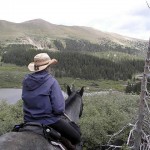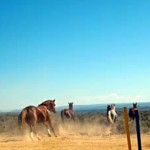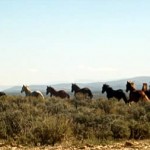
Dear Friends of the Wild;
I moved to Colorado nearly 40 years ago, captivated by the wild beauty of this inspiring place. Here I could immerse myself in true wilderness where opportunities existed to glimpse animals I had only seen in pictures — mountain lions, bighorn sheep, mule deer, elk, black bears, golden eagles, mountain goats, and even wild horses.
Much has changed in these last four decades. Colorado has been highly developed on the front range of our magnificent Rockies, but there are still those hauntingly beautiful, undisturbed landscapes I once dreamed about. Linda Hanick, an extraordinary Colorado wild horse advocate, writes about one of them in her report below.
Our state has only a few hundred wild horses remaining and often they live tucked away in secluded country like that visited by Linda last week. She was present on the last day of the largest roundup of the year in Colorado. Over two hundred robust, glowing mustangs were stampeded by a helicopter, losing in an instant what they value most — their freedom and their families. I encourage you to read the account of her journey to Colorado’s western slope.
We have a lot of hard work ahead of us to preserve the few thousand remaining wild horses and burros on our public lands. The Cloud Foundation needs your support to carry on our work to protect Cloud and his family, and all the remaining wild horse families in the West. With your help I know we’ll win a victory for them!
Happy Trails!
Ginger
P.S. Thanks for all your notes and kind wishes, and for your enthusiastic response to my speech at the recent International Equine Conference in DC. Many thanks to those who put on this impressive event.
E. Douglas/Piceance, CO Roundup
Sept. 21-30, 2011
A Field Report by Linda Hanick
September 30, 2011: Predawn, 6:00 am. I met Dave Boyd (Silt, CO BLM Public Affairs Officer) and Kent Walter (White River Manager – Meeker BLM) in Meeker, CO and followed them to the roundup, about an hour away. We arrived at the observation site at 7:00 am, and the helicopter was at work, flying the high ridges, looking for horses. It was a beautiful fall Colorado day, this last day of the roundup, and Cattoor (the contractor hired for this roundup) was looking for 10 horses that had been hanging out on County Road 5, on the east side of the HMA. This first photo is taken from the observation site. Vegetation and grass were still abundant, as 2011 brought great moisture to this area, and these horses have had an abundance of good eating.
We stood on a high ridge, so we could see the helicopter as it flew over the valleys and along all the side slopes of the ridges.
The trap site was not close — about 1/4 -1/2 mile away — and with binoculars, I could see it, but not well. So, I knew I would not get good photos of any horses in the trap with my camera. That morning, I briefly met Melissa Kindall, BLM Range Tech. The holding corrals for the previously captured horses were on private land, but I would go there after the helicopter was finished, where Sue Cattoor would give me the tour. I was handed 2 pages of whitewashed descriptions of what a great job Cattoor does in handling the horses both during the roundup and in the corrals.
It was a congenial morning, and since I was the only observer, I had a great opportunity to talk with all the BLM people there, including Jason the ranger from Moab, as well as Jimmie, Tyrrell, and James from Meeker — while we waited for the helicopter to begin driving in horses. There were probably others, but those are the names I remember in addition to Kent and Dave. We discussed the disastrous roundup here last October, when Sun J Livestock completed their 1st contract, and three horses died as a direct result of the roundup. A handful more were euthanized because of “pre-existing conditions” — all this out of a total of 73 horses rounded up. They overestimated the number of horses in that roundup as well — they planned on removing 140 horses and only found 73.
While we were discussing the 2010 roundup, I interpreted the BLM comments about “mistakes made” to mean that hiring an inexperienced contractor was a mistake and that, in hindsight, they should not have selected them. We had some good discussions, agreeing to disagree on some things.
All in all, it was a congenial and respectful atmosphere. A comment was made regarding the reproduction rate which one of the BLM people said is closer to 15-16% instead of the 20%. (USGS field research showed it to be more like 15%, without mortalities.) With mortality numbers rolled in, it would take a herd of 135 horses seven years to double in size — not the 4 years stated in BLM PR releases.

Prior to that morning, Cattoor had rounded up 277 horses — 104 on the first day. I asked if that high number in 1 day was unprecedented, and they explained that Cattoor had 2 helicopters in the air for the first few days, before one had to go in for scheduled maintenance. A couple of days before I arrived, they captured a mare and her foal. The mare had leg injuries. They determined that the she had previously injured her leg which had healed, and that probably contributed to this injury. After watching her for a couple of days, it was determined that she would be euthanized, and the foal was shipped to Canon City. This is consistent with what I have seen — if a horse is less than perfect, it is often killed. I also learned about a horse that had come into the trap with a lot of cuts, probably from some old barbed wire. This week I checked with Canon City, and they said they had treated a couple of horses with cuts, but, to my relief, there was nothing that needed a vet’s attention and they were doing fine.
For a little background on this roundup, last spring’s aerial census indicated that there were 382 horses in this area. The plan was to remove 382 horses, return 135 to the HMA, and ship the remaining 247 to Canon City. It looked good on paper, but 135 is the low end of the AML, and the high end is 235. The plan also included PZPing mares to help control population.
As of that morning, they had removed 277 horses, with one euthanized. And they were looking for 10 that morning, so they were still 100 short of their population census. Cattoor complained that he couldn’t find the horses in the trees, and I prayed that the horses would stay hidden.
The APHIS vet, Richanne, was the same vet that was there last year. She isn’t very talkative, but I was told that she was on site with the horses at all times — in the trap or in the holding corrals.
As the morning progressed, the helicopter flew fruitlessly. By 9 am, they called the roundup, saying they couldn’t find the horses anywhere. With a smile, I uttered a little thank you to myself, saying those 10 got a new lease on life that day. At this point, Kent said I could go to the corrals or I could watch them release the horses they were returning to the range. I decided that I would do that — the rest in the corrals were being loaded into trucks headed for Canon City.
When we left the observation site to head to the release site, I stopped at the trap site as they were beginning to dismantle it. Dave Cattoor was leading this job.
As I was driving to the release site, I did the math: They found 277 horses, not the 382 that they anticipated. They shot one, they shipped 261 to Canon City, and they were releasing only 15 wild horses — 9 stallions and 6 mares. I sure hope I’m wrong, and they’re right about horses hiding in the dense tree cover. Otherwise, the E. Douglas/Piceance herd has been stripped far below levels for genetic viability, even with those 10 that they couldn’t find that morning.

The mares and stallions to be released (none of the mares were treated with PZP) were in 2 separate trailers, and here is the very quick chronology of their release. Once the doors were opened, they leaped out of the trailers as if shot from a cannon. They never looked back as they disappeared over the edge of the mesa. The grey stallion is the one that Pam Nickoles has photographed numerous times – “Handsome” is his name, and he certainly is. He was one of the first ones to shoot out of the trailer, but he lagged back, and he and the buckskin brought up the rear — ever a band stallion.
I then headed for home — driving slowly and looking for horses. There were none to be seen. As I drove, my bittersweet thoughts ranged from elation for those 15 whom I saw disappear in the dust, and sadness, both for the many horses now on their way to Canon City short-term holding, and for the future of this herd. The BLM is slowly chipping away at the numbers of our wild horses, one herd at a time. The beautiful golden aspen groves were the only bright spots on the rest of my drive that afternoon as I headed home across the mountains.
The Cloud Foundation
107 South 7th St
Colorado Springs, CO 80905
719-633-3842
Dear Ginger,
Hello from Ocala, FL. A few years ago you graciously spoke with our equine studies students at the College of Central Florida. We feel priveledged to have had you discuss the plight of wild horses with our students and we have continued to bring attention to the conflicts that arise from our government getting involved with the “management” of our wild horse herds.
I am teaching equine behavior this semester and I have used your Cloud videos as a tool for teaching instinctive equine behaviors for several years. Our students enjoy the story of the wild horses and Cloud, but the majority of them are not aware (until they take this class) of the brutal consequences of the round-ups and the methods used by the BLM to influence the herds. This evening we just finished the 2nd Cloud video and during our discussion afterwards, I mentioned that there is a mustang sale this weekend in Ocala. Several students asked where this group of sale horses was captured. Is there a way for me to find that information? I know very little about these sales because I have never been a supporter of marketing mustangs under these “sale” conditions. What I do understand is that these horses come from round-ups and are shipped to a “holding center” (Which I think is in Jackson, Missouri though I’m not positive), then sent to the auction site which is the Ocala Equestrian Center this February 2,3,4. I’d be so appreciative of any leads you could give me to find the correct information of how this group of horses got from the round-up to the auction site. If possible, I’d like to find which herd(s) they originated from, so we can ask pointed questions to the government officers who are responsible for them. I am planning to take several students to the auction so we can continue to educate our students on this topic.
Thanks for all that you do to defend the rights these horses have to remain on their homelands. The impact of your visit to our department has remained strong.
Sincerely,
Betsy Gamberino
College of Central Florida
Departments of Equine Studies and Biology
Ocala, Florida
The only way to save the remaining wild horses is to round them up privately and place them on private sanctuaries. They are not the private property of any federal agency.